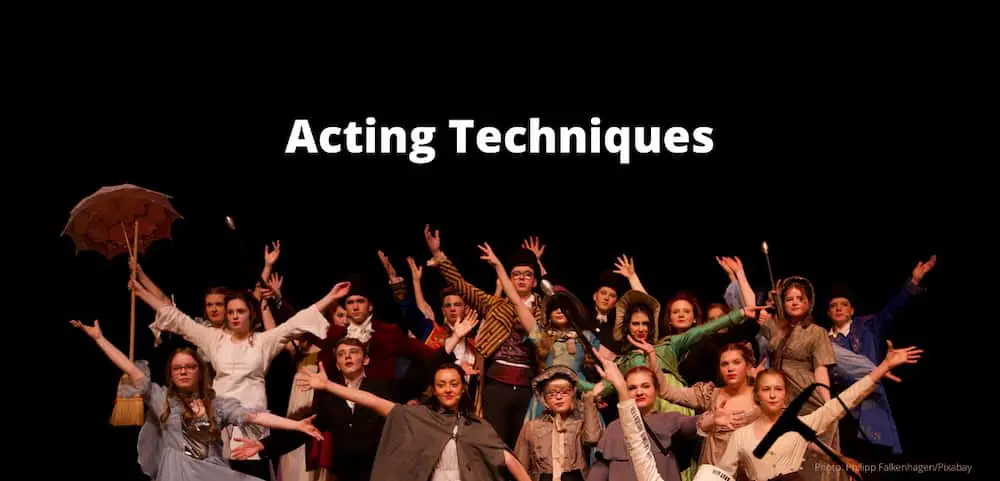Acting techniques help trained actors portray their roles with depth and expertise. Actors’ training teach the art of bringing believable and realistic characters to appreciative audiences with these systems and methods.
Good actors must learn and finesse a wide range of skills. These include memorisation, voice projection, movement, characterisation, and crying on demand. Also audition techniques, screen acting and stage acting, and recording self tapes. Choosing what to wear for headshots and auditions. Plus the accounting and marketing skills of running a business, including networking.
But over the past century the performing art of being a good actor in front of an audience or camera has developed into different acting techniques and systems. Let’s find out about some of these different acting techniques.
List of Acting Techniques
Many well respected acting techniques help good actors portray characters on stage and screen. These acting techniques are taught in leading drama schools and specialist acting workshops.
List of acting techniques examined on this page
.
Classical Acting Technique
A wide range of performing art skills come under the umbrella of classical acting. Using the body and voice to communicate the character to the audience, in familiar actions for each emotion. Stage combat and natural movement in unfamiliar period clothing takes practice. Traditional dances and speaking in Shakespearean verse are important too.
.
Stanislavski Method
Stanislavski’s system, also known as Stanislavski’s method, is a system of realism in acting. Actors draw on their own feelings and experiences (emotional memory) to portray the “truth” of their character. In particular, actors examine what they’d feel and do if the narrative was their reality.
Konstantin Stanisalvski
- Born: 17 January 1863, Moscow, Russia
- Died: 7 August 1938, Moscow, Russia
- Russian actor and director
You can find out more about the Konstantin Stanislavski technique in our article about the Stanislavski System.
.
Michael Chekhov Acting Technique
Michael Chekhov one of Stanisalvski’s most brilliant pupils. He was also the nephew of famous Russian playwright Anton Chekhov.
The Michael Chekhov acting technique takes a ‘psycho-physical approach’. Actors use parts of themselves that are not just the banal elements that make up their daily life, but rather parts of their unconscious, to draw upon imagination, feelings and atmosphere. Central to this acting technique is transformation through impulse, imagination and inner and outer gesture.
Michael Chekhov
- Born: 29 August 1891, Saint Petersburg, Russia
- Died: 30 September 1955, Beverly Hills, California, United States
Followers of the Michael Chekhov acting technique include Jack Nicholson, Clint Eastwood, Marilyn Monroe, and Yul Brynner.
.
Michel Saint-Denis Technique
Michel Saint-Denis was a French actor, theater director, and drama theorist. Michel Saint-Denis was profoundly influenced by the teachings of his uncle, Jacques Copeau, who established both the Théâtre du Vieux-Colombier and the Ecole du Vieux-Colombier.
His influence on twentieth century European theatre is often overlooked today. But during his lifetime he established, developed or worked for many notable theatre institutions.
Together with his uncle, he established the now-famous dramatic troupe Les Copiaus in Burgundy and the Compagnie des Quinze in Paris. With George Devine and Marius Goring he founded the the London Theatre Studio in Islington, then co-directed the RSC (Royal Shakespeare Company). After a wartime stint as Jacques Duchesne directing the BBC’s French programme Radio Londres, Saint-Denis founded a new theater school at the damaged Old Vic. In the 1950s he worked at the Centre Dramatique de l’Est at Colmar and then Strasbourg, before founding the Ecole Supérieure d’Art Dramatique at Stragbourg’s Théâtre National.
Even in a retirement prompted by ill health, he kept working. When the world-famous Juilliard School opened in 1968, Saint-Denis became consultant director of the drama division. He also served as an advisor to the National Theatre School of Canada and became artistic advisor at the new Royal Shakespeare Company. In 1966, he narrated five episodes of BBC’s Jackanory.
The Dramatic Theory of Michel Saint-Denis
Saint-Denis used teaching, lectures and books to influence dramatic theory and practice in both rehearsal spaces and acting classrooms. He published ‘Theatre’, ‘Theatre, the Rediscovery of Style’, and ‘Training for the Theatre’.
‘Theatre, the Rediscovery of Style’ is a collection of five key lectures he gave in America. It perfectly encompasses his synergy of classical theatre and modern realism.
He then used ‘Training for the Theatre’ as a practical resource for actors, directors and teachers. Topics included understanding a play’s context, training schedules, improvisation and dealing with stage space. There’s also a section about his use of masks in actor training.
Michel Saint-Denis
- Born: 13 September 1897, Beauvais, France
- Died: 31 July 1971, London
- Other name: Jacques Duchesne
- Books: Theatre, Theatre, the rediscovery of style, Training for the theatre
.
Brecht’s Method
Bertolt Brecht developed a type of political theatre that addressed contemporary issues, known as Epic Theatre. Later he preferred to call it dialectal theatre.
Epic Theatre or dialectal theatre focuses on facts and reality shown across a series of loosely connected scenes. Brecht’s method rejects illusion and escapism. Instead, the audience is given analysis, argument, or documentation, which sometimes interrupts the storyline and emotional involvement. Emotion is rejected for the audience’s reflective detachment.
Bertolt Brecht
- German theatre practitioner, playwright, and poet
- Born: 10 February 1898, Augsburg, Germany
- Died: 14 August 1956, East Berlin
.
Stella Adler Technique
In 1949, American actress, director and acting teacher Stella Adler founded the Stella Adler Studio of Acting in New York City. Later, she helped bring the Stella Adler technique to acting classes in Los Angeles. She also worked as an associate producer for MGM in the early 1940s and throughout the 1940s and 1950s directed commercial theatre in New York City.
Adler was highly influenced by Stanislavski. But she added her own many years of acting experience into her theory and practice, altering some of Stanislavski’s ideas. Furthermore, her ideas are not considered method acting.
The Stella Adler technique is different from others because actors use real observations and imagination to produce the actions and emotions of believable characters, creating a fictional life in reality, instead of the personal memories and emotional recall demanded by the Stanislavski system.
She felt actors would limit their performances if they relied solely on personal experience. Instead, one of the principles of the Stella Adler technique is an understanding of the world and other people’s experiences, augmented with imagination to experience the feelings of others.
One of the Stella Adler exercises include randomly picking a line from an unfamiliar play, and bringing it to life with a detailed imagination of the reasons to say that line. Another is to take an idea from a written text and retell it in your own words.
Stella Adler
- Born: 10 February 1901, New York, New York, United States
- Died: 21 December 1992, Los Angeles, California, United States
.
Lee Strasberg’s Method Acting
In New York’s world famous Actors Studio, Lee Strasberg developed Stanislavski’s System for stage actors into the screen acting technique known as Method Acting. Emotional and cognitive understanding of their roles helps actors use their own experiences to identify and deeply connect with their character’s emotions.
Lee Strasberg’s method acting technique is probably the best known among non actors. This is perhaps due to the dominance of film and television in popular culture. Outside the creative industries, people may struggle to name talented classical actors. But ask them to name a successful actor or two, and you’ll hear academy award winners who appear in blockbuster movies. Many of them trained as a method actor, since it’s one of the few early major acting techniques to concentrate on screen performances in acting class.
Lee Strasberg
- Born: 17 November 1901, Budaniv, Ukraine
- Died: 17 February 1982, New York, United States
.
Meisner Technique
The Meisner technique centres the actor’s attention on living truthfully under imaginary circumstances.
Developed from Stanislavski’s System, the Meisner acting method helps actors bring truth and authenticity to their role through emotional response to the actors and circumstances in the scene. The Meisner actor focuses entirely on their stage partner as though they are real, only existing in that moment.
Meisner developed the Repetition Exercise or Repetition Word Game to move the actor’s focus from themselves to their stage partner. It both removes self-consciousness and increases listening skills. The Practical Aesthetics acting style discussed below also uses repetition exercises.
Although the Meisner Technique and Lee Strasberg’s Method Acting technique are both developed from the Stanislavski’s System, the Meisner acting method is not considered method acting.
Sanford “Sandy” Meisner
- Born: 31 August 1905, Brooklyn, New York, United States
- Died: 2 February 1997, Sherman Oaks, Los Angeles, California, United States
.
Viola Spolin Technique
The Viola Sponlin technique uses games and exercises to organically teach students drama through experiential learning. The acting technique has improvisation and creativity at its heart. Students must keep an eye on the game’s aim, while being open to anything happening, enhancing spontaneity and living in the moment.
The games make everyone equal and there should not be competition. Then the group can focus on their shared aim, and develop creativity both as individuals and as an organic whole. Removing self-consciousness, pre-planning, and judging increases spontaneity.
Who Was Viola Sponlin?
Sponlin was an actor and director who went on to become an influential acting teacher, coach and author. Her theories were inspired by her early work with disadvantaged children at Neva Boyd’s Group Work school in Chicago, as drama supervisor with the Works Progress Administration, and running her Young Actor’s Company in Hollywood.
In 1955, her son Paul Sills set up improvisational cabaret ensemble The Compass Players alongside David Shepherd. Four years later he launched improvisation company The Second City with Bernie Sahlins and Howard Alk. Sponlin worked with both groups, bringing her expertise in theatre games to wider attention.
When the Spolin Theatre Game Centre opened in Hollywood in 1976, its aim was to train professional theatre games coaches, and the Sponlin technique
Viola Sponlin’s ‘Theatre Games for the Classroom: A Teacher’s Handbook’, and ‘Improvisation for the Theatre: A Handbook of Teaching and Directing Techniques’ (1963), and ‘Theatre Games for Rehearsals: A Director’s Handbook’ (1985), were among her well received published works.
Viola Sponlin Quotes
‘Everyone can act. Everyone can improvise’
‘If you have a problem, you can use a game, you are taking it out of the head where you think about it . . and you are getting it into the body, body-mind intuition, that is what we are after, body-mind intuition’.
‘That which is not yet known comes out of that which is not yet here.’
‘Individual freedom (expressing self) while respecting community responsibility (group agreement) is our goal’.
‘Be thrown off-balance and blank out the intellect (the known).’
‘The intuitive can only respond in immediacy – right now. It comes bearing its gifts in the moment of spontaneity, the moment when we are free to relate and act, involving ourselves in the moving, changing world around us.’
‘no-one knows the outcome of a game until one plays it’
Viola Sponlin
- Born: 7 November 1906, Chicago, Illinois, United States
- Died: 22 November 1994, Los Angeles, California, United States
.
Uta Hagen Technique
Uta Hagen was a young child when she moved from Germany to the United States and was a successful Broadway actress by the age of 18. Despite being on the Hollywood Blacklist during the early years of the Cold War, Hagen worked on stage with a long list of notable actors and twice won a Tony Award. To a lesser extent she worked in film and television roles, earning a Daytime Emmy Award nomination.
Besides her busy career as an actress, Uta Hagen also taught at the renowned New York acting school HB Studio. Many of her students became legendary stars of stage and screen.
What are Uta Hagen’s 9 questions?
Uta Hagen’s first book, ‘Respect for Acting’ (1973), sets out nine questions an actor should ask and examine about the character as they prepare for a role:
- 1. Who am I?
- 2. What time is it?
- 3. Where am I?
- 4. What surrounds me?
- 5. What are the given circumstances?
- 6. What are my relationships?
- 7. What do I want?
- 8. What obstacles can stop me getting what I want?
- 9. What do I do to get what I want?
It may be necessary for an experienced acting coach to lead a young actor through these nine character questions.
In A Challenge for the Actor (1991), Hagen alters or develops her perspectives on several matters covered in her first book.
The process of ‘substitution’, where elements of an actor’s life feed their character work, is now known as ‘transference’. The actor should connect the character’s feelings and circumstances with their own life, but those thoughts and feelings must instigate the body language to reveal the character to the audience.
So the nine character questions in the Uta Hagen method now become object exercises, requiring an experienced coach for actors where necessary. Relying on the acting book alone can be problematic where aspiring actors have yet to gain a lot of experience.
Uta Hagen
- Born: 12 June 1919, Göttingen, Germany
- Died: 14 January 2004, Manhattan, New York, United States
.
Ion Cojar Technique
The Ion Cojar technique rejects the conventional Romanian acting method of mimicry and pretence in favour of actors developing psychologically realistic processes, focussing on the character’s personality and goals, leading to natural and believable speech and movement which is devoid of conscious control or anticipation.
In real life, you don’t know what will happen or the words you’ll say later today. Instead, we interact with the people around us in a subtle dance to achieve our goals. We buy something, find out information, or bond with friends and family. We don’t practice what we’ll say and how we’ll move, and obstacles are unknown. If you get angry or embarrassed, there’s a notable change in your face, movement and speech. Cojar wants that genuine reaction from the actors.
A famous Ion Cojar quote is “the art of the actor has nothing in common with theatre”.
You can discover more about the Ion Cojar Technique in his book, ‘Poetics of the actor’s art’ (‘O poetică a artei actorului’).
Ion Cojar
- Born: 9 January 1931, Recaș, Romania
- Died: 18 October 2009, Bucharest, Romania
.
Practical Aesthetics Technique
David Mamet and William H. Macy created a modern acting technique known as Practical Aesthetics, developed from the Stanislavski technique, Meisner technique, and teaching of Greek Stoic philosopher Epictetus. It’s taught at New York’s Atlantic Acting School.
With the Practical Aesthetics technique, script analysis identifies what characters are doing and want, to reveal truthful actions. Repetition exercises in the Moment block focus actors’ attention on the other person so they act spontaneously and truthfully based on what they see.
David Mamet
- American playwright, film director, screenwriter and author
- Born: 30 November 1947, Chicago, Illinois, United States
William H Macy
- American actor and director
- Born: 13 March 1950, Miami, Florida, United States
.
Actor training for the aspiring actor
Although getting into drama school is difficult, the intense period of learning how to build character and develop a confident acting style with one of more acting techniques usually increases your chances of forging a successful career as a professional actor.
Yet it is possible to get into acting without drama school. Many professional actors have found other ways to discover and develop an acting style which belongs to one of the methods described in this list of acting techniques.
All performers, even famous actors, continue to invest in their career with regular coaching and workshops. Sometimes an actor prepares for a role with an acting coach, other times it’s attending an improv class or learning how to improve their audition technique. Attending an actor’s studio to learn more about one of these methods from this list of acting techniques could take your performing art to the next level and help boost your career as a professional actor.





